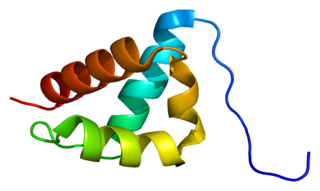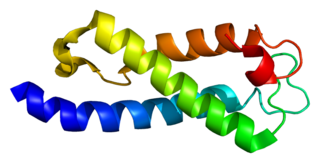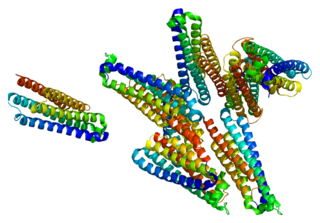This page is based on this
Wikipedia article Text is available under the
CC BY-SA 4.0 license; additional terms may apply.
Images, videos and audio are available under their respective licenses.
The hip is an anatomical region and a joint.
Actin-binding protein are proteins that bind to actin. This may mean ability to bind actin monomers, or polymers, or both.

The death-effector domain (DED) is a protein interaction domain found only in eukaryotes that regulates a variety of cellular signalling pathways. The DED domain is found in inactive procaspases and proteins that regulate caspase activation in the apoptosis cascade such as FAS-associating death domain-containing protein (FADD). FADD recruits procaspase 8 and procaspase 10 into a death induced signaling complex (DISC). This recruitment is mediated by a homotypic interaction between the procaspase DED and a second DED that is death effector domain in an adaptor protein that is directly associated with activated TNF receptors. Complex formation allows proteolytic activation of procaspase into the active caspase form which results in the initiation of apoptosis. Structurally the DED domain are a subclass of protein motif known as the death fold and contains 6 alpha helices, that closely resemble the structure of the Death domain(DD)

The huntingtin gene, also called the HTT or HD gene, is the IT15 gene, which codes for a protein called the huntingtin protein. The gene and its product are under heavy investigation as part of Huntington's disease clinical research and the suggested role for huntingtin in long-term memory storage.

In biology, scaffold proteins are crucial regulators of many key signalling pathways. Although scaffolds are not strictly defined in function, they are known to interact and/or bind with multiple members of a signalling pathway, tethering them into complexes. In such pathways, they regulate signal transduction and help localize pathway components to specific areas of the cell such as the plasma membrane, the cytoplasm, the nucleus, the Golgi, endosomes, and the mitochondria.

Huntingtin-interacting protein 1 also known as HIP-1 is a protein that in humans is encoded by the HIP1 gene.

Kalirin, also known as Huntingtin-associated protein-interacting protein (HAPIP), protein duo (DUO), or serine/threonine-protein kinase with Dbl- and pleckstrin homology domain, is a protein that in humans is encoded by the KALRN gene. Kalirin was first identified in 1997 as a protein interacting with huntingtin-associated protein 1. Is also known to play an important role in nerve growth and axonal development.
Huntingtin-associated protein 1 (HAP1) is a protein which in humans is encoded by the HAP1 gene. This protein was found to bind to the mutant huntingtin protein (mHtt) in proportion to the number of glutamines present in the glutamine repeat region.

Optineurin is a protein that in humans is encoded by the OPTN gene.

Pre-mRNA-processing factor 40 homolog A is a protein that in humans is encoded by the PRPF40A gene.

E3 ubiquitin-protein ligase RING2 is an enzyme that in humans is encoded by the RNF2 gene.

Mitogen-activated protein kinase kinase kinase 10 is an enzyme that in humans is encoded by the MAP3K10 gene.

Endophilin-A3 is a protein that in humans is encoded by the SH3GL3 gene.

SET domain containing 2 is an enzyme that in humans is encoded by the SETD2 gene.

Arfaptin-2 is a protein that in humans is encoded by the ARFIP2 gene.

Intraflagellar transport protein 57 homolog is a protein that in humans is encoded by the IFT57 gene.

Palmitoyltransferase ZDHHC17 is an enzyme that contains a DHHC domain that in humans is encoded by the ZDHHC17 gene.

Kinesin heavy chain isoform 5C is a protein that in humans is encoded by the KIF5C gene.















